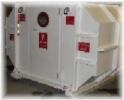MSHA Alerts Mines About Oxygen Risks of Rescue Chambers
The alert reminds underground mine personnel that the chambers' oxygen systems must be protected against damage when the chambers are moved, or dangerous conditions could result during an actual emergency.
MSHA posted a new Safety Alert that reminds underground mine personnel that oxygen systems inside portable refuge chambers must be protected against damage when the chambers are moved, or dangerous conditions could result when miners use the chambers in an actual emergency. Chambers, also called refuge alternatives and shelters, are designed to protect miners for 96 hours as they await rescue, so they contain high-pressure compressed oxygen cylinders that remain in a “ready state” until being deployed during an emergency, the alert notes.
 "A dangerous condition can occur if the compressed oxygen system is damaged during movement of the refuge alternative," it states. "Sudden jerks, impacts, or improper handling may result in a leak in the compressed oxygen system. A slow leak can occur resulting in accumulations of oxygen. During the stress of a mine emergency, an improperly adjusted oxygen flow rate or unintentional damage to the system by miners can result in an oxygen enriched atmosphere inside of the refuge alternative. An oxygen enriched atmosphere increases the chances of spontaneous ignitions of materials, such as rags, miners’ clothing, papers, or cardboard boxes, containing coal dust, oil, or grease."
"A dangerous condition can occur if the compressed oxygen system is damaged during movement of the refuge alternative," it states. "Sudden jerks, impacts, or improper handling may result in a leak in the compressed oxygen system. A slow leak can occur resulting in accumulations of oxygen. During the stress of a mine emergency, an improperly adjusted oxygen flow rate or unintentional damage to the system by miners can result in an oxygen enriched atmosphere inside of the refuge alternative. An oxygen enriched atmosphere increases the chances of spontaneous ignitions of materials, such as rags, miners’ clothing, papers, or cardboard boxes, containing coal dust, oil, or grease."
The alert lists these best practices:
- Train all miners in the proper deployment and operation of the breathable air system during a stressful situation.
- Train all miners on the dangers of an oxygen-enriched atmosphere and how to determine whether a dangerous condition exists in the chamber during deployment.
- Train miners on methods of eliminating oxygen-enriched atmospheres, including adjusting flow rates, replacing plumbing components, and purging the unit.
- Use people who have been trained in the proper procedures to move the chambers.
- After the move is completed, make a thorough examination of the atmosphere inside access panels and near the chamber for accumulations of oxygen that would indicate a leak in the compressed oxygen system.
- If an oxygen leak is discovered, shut off the source of the leak and ventilate the area to remove the oxygen-enriched atmosphere. Report any damage that occurred during the move.
- Conduct proper preshift examinations of the chamber according to the manufacturer's recommendations to determine the condition of the compressed oxygen cylinders and plumbing.
- Remove coal dust, grease, and oil from the interior of the chamber or areas near any oxygen system components using appropriate cleaning materials, because they can ignite in an oxygen-enriched atmosphere.
- Use electrical components inside the chamber that are MSHA approved as intrinsically safe or housed in an explosion-proof enclosure.
- Never refill oxygen cylinders underground.
The alert concludes with this: REMEMBER: The risk of accidental ignition is present with all oxygen systems!